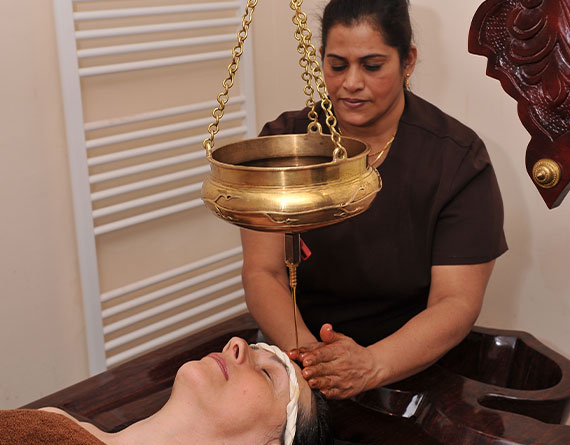Philosophy Of Ayurveda
Ayurveda is based on six ancient Indian philosophies, many physical/behavioral sciences, and medical arts. Ayurveda mainly deals with the healing of the sick, maintenance of the health of the healthy, and preventing disease in order to promote quality and length of life. In Ayurveda health is defined as an experience of bliss/happiness in the soul, mind, and senses and balance of the doshas (humor or body’s three governing principles), seven tissues, three wastes, digestion, and other processes such as immune function.
Health is not the absence of symptoms. Ayurveda has objective ways to assess each of these, pulse assessment being the primary means. According to Ayurveda life is a combination of body, mind, and soul. The physiology of Ayurveda is mainly based on the balance of three doshas, viz. the vata (wind), pitta (bile), and kapha (phlegm). Vata signifies the dynamic, energetic, nonmaterial aspect of nature and governs respiration, circulation, elimination, locomotion, movement, speech, creativity, enthusiasm, and the entire nervous system.
Pitta signifies the transformative aspects and governs transformations such as digestion and metabolism, vision, complexion, body temperature, courage, cheerfulness, intellect, and discrimination. Kapha signifies the structural/physical aspects and governs growth (anabolic processes), lubrication, fluid secretions, binding, potency, patience, heaviness, fluid balance, compassion, and understanding in the organism. In the human body, these three energies tend to interact in a harmonious and compensatory way to govern and sustain life. Their relative expression in an individual implies a unique ratio of functioning of these governing principles according to each person’s unique DNA (vta-pitta-kapha ratio) determined at conception (genotype). This is body or constitutional typing, called Prakriti (phenotype).
There are seven types – vata type, pitta type, kapha type, and combinations thereof. Prakruti yields two important understandings. A person has a permanent or stable nature for his entire life and efforts to maintain or change physiology must keep this balance point in mind. In addition, each type will suggest an area tending to go out of balance, a disease tendency, requiring lifelong attention to maintain balance.
A vata type naturally tends to constipation, arthritis, and anxiety; a pitta type tends towards inflammations, infections, and ulcers; and kapha types tend to be overweight, have diabetes, congestive disorders, etc. The implication of Prakriti is that it helps explain why people react differently to the same things.
The medical implication for this is that certain people will have a natural predisposition or sensitivity to certain medicines and this can be predicted. The imbalance in the doshas occurs due to one or more of the energies or elements described above getting increased quantitatively or altered qualitatively. There is no human experience, whether a thought, an emotion, the climate, food, lifestyle, etc. that does not have an effect on the doshas. Eg., heat increases pitta, dryness increases vata, and liquid increases kapha, etc.
Thus imbalance is the continued experience of some stimulus – mental, emotional, or physical, real or imagined – that overwhelms the body’s ability to maintain its identity, its Prakriti or vata-pitta-kahpa ratio. When a stimulus and a system have the same energy the stimulus promotes more of its value in the system. When disease begins to manifest the doshas are called dushyas (one which pollutes or impurities/toxins), which can pollute or contaminate the physiology.
Thus Ayurveda believes in keeping the doshas in harmony by following a proper diet and lifestyle suitable for specific dosha types to stay healthy. In disease conditions based on which of the doshas are affected the factors responsible for the vitiation of that particular doshas are to be avoided. Also, the principles of treatment in Ayurveda are based on these doshas, i.e., avoidance of the causative factors, maintaining proper diet and lifestyle (massage and other therapies); providing herbal concoctions for balancing the doshas; elimination of vitiated doshas using Panchakarma (the five cleansing procedures); or even surgeries (which is not a regular practice in modern Ayurveda).
Pitta signifies the transformative aspects and governs transformations such as digestion and metabolism, vision, complexion, body temperature, courage, cheerfulness, intellect, and discrimination. Kapha signifies the structural/physical aspects and governs growth (anabolic processes), lubrication, fluid secretions, binding, potency, patience, heaviness, fluid balance, compassion, and understanding in the organism. In the human body, these three energies tend to interact in a harmonious and compensatory way to govern and sustain life. Their relative expression in an individual implies a unique ratio of functioning of these governing principles according to each person’s unique DNA (vta-pitta-kapha ratio) determined at conception (genotype).
This is a body or constitutional typing, called Prakriti (phenotype). There are seven types – vata type, pitta type, kapha type, and combinations thereof. Prakruti yields two important understandings. A person has a permanent or stable nature for his entire life and efforts to maintain or change physiology must keep this balance point in mind. In addition, each type will suggest an area tending to go out of balance, a disease tendency, requiring lifelong attention to maintain balance. A vata type naturally tends to constipation, arthritis, and anxiety; a pitta type tends towards inflammations, infections, and ulcers; and kapha types tend to overweight, diabetes, congestive disorders, etc. The implication of Prakriti is that it helps explain why people react differently to the same things. The medical implication for this is that certain people will have a natural predisposition or sensitivity to certain medicines and this can be predicted. The imbalance in the doshas occurs due to one or more of the energies or elements described above getting increased quantitatively or altered qualitatively. There is no human experience, whether a thought, an emotion, the climate, food, lifestyle, etc. that does not have an effect on the doshas. Eg., heat increases pitta, dryness increases vata, and liquid increases kapha, etc.
Thus imbalance is the continued experience of some stimulus – mental, emotional, or physical, real or imagined – that overwhelms the body’s ability to maintain its identity, its Prakriti or vata-pitta-kahpa ratio. When a stimulus and a system have the same energy the stimulus promotes more of its value in the system. When disease begins to manifest the doshas are called dushyas (one which pollutes or impurities/toxins), which can pollute or contaminate the physiology. Thus Ayurveda believes in keeping the doshas in harmony by following a proper diet and lifestyle suitable for specific dosha types to stay healthy. In disease conditions based on which of the doshas are affected the factors responsible for the vitiation of that particular doshas are to be avoided.
Also, the principles of treatment in Ayurveda are based on these doshas, i.e., avoidance of the causative factors, maintaining proper diet and lifestyle (massage and other therapies); providing herbal concoctions for balancing the doshas; elimination of vitiated doshas using Panchakarma (the five cleansing procedures); or even surgeries (which is not a regular practice in modern Ayurveda).





